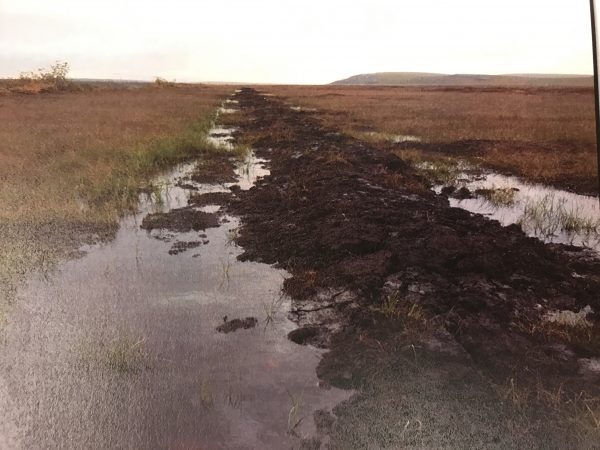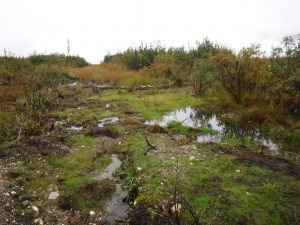
Thawing permafrost is creating a muddy mess in Alaska’s Arctic after two competing broadband projects dug trenches alongside the Dalton Highway for their separate fiber optic cables.
The telecommunications competitors leading those projects — Quintillion Networks and a subsidiary of GCI Liberty — are now embroiled in a legal dispute over who is to blame.
At the same time, state officials are still trying to sort out the scope of a problem that could potentially threaten the only haul road to the oil fields at Prudhoe Bay, as well as dozens of streams along the way.
The two-lane gravel highway to the North Slope can see a couple hundred vehicles a day, between semi-trucks, tourist buses and others. The Dalton runs through forested, mountainous and tundra-covered terrain, and a lot of it sits atop permafrost.
If the permafrost stays frozen, the ground under the roadway stays stable. But in some spots right next to the highway, it’s not. That’s because if you remove the topsoil and vegetation that insulates the icy soil in summer, there’s a good chance it’s going to thaw and keep thawing.
State officials say that’s what happened after the trench-digging, and they’re worried it could spread.
“We work really hard to make sure that the frozen ground underneath those embankments stays frozen,” state Transportation Commissioner Marc Luiken said.
The Department of Transportation is one of three agencies to permit subsidiaries or subcontractors of Quintillion and GCI to dig trenches in its right of way, along with the Department of Environmental Conservation and the U.S. Army Corps of Engineers.
It’s possible the trench-related thawing will threaten the highway, Luiken said.
“You know, that is the primary supply route up for that pretty significant industry up there,” Luiken said.
Luiken means, of course, the oil industry. But another industry has staked its claim in the Arctic.
Prospectors like GCI and Quintillion want to tap into a market that’s thirsty for cheaper and more reliable internet and phone service by using those fiber optic cables alongside the Dalton Highway to connect some of Alaska’s farthest-flung communities to the rest of the state’s networks. They’ll also hook up to a sub-sea cable linking Asia, North America and Europe, another massive and highly touted project Quintillion is also working on separately.
Faster and more affordable internet sounds great to Alaskans only served by microwave and satellite connections. But that has meant disturbing miles and miles of permafrost-insulating vegetation to dig the trenches to lay the fiber optic cables.
Both projects’ permits cover 240 miles of digging and require remediation of the ground, as well as preventing erosion and runoff of muddy water. But there are still at least 20 swampy problem areas parallel to the highway that range from 20 feet to 500 feet long. One inspection report even notes erosion caused the fiber optic cable itself to be left exposed in at least one spot.

Dr. Vladimir Romanovsky with the University of Alaska Fairbanks Geophysical Institute studies environmental and engineering problems involving ice and permafrost. Romanovsky has seen the melting along the Dalton Highway.
“It’s kind of a trench, with sometimes standing water in it. Sometimes even moving water,” Romanovsky said. “It’s just strange and unattractive, I would say. We were joking that someday we may start to use, instead of trucks, we’ll use boats, like in Venice. Just go along the Dalton Highway in the boat.”
Romanovsky said the companies digging the trenches for GCI and Quintillion apparently didn’t know any better. That’s unfortunate, he said, because oil producers on the North Slope have been working on and around permafrost for decades. The cost of dealing with impacts to the environment and to infrastructure from turning solid, frozen ground into soupy muck should be well understood by now, Romanovsky said.
“But usually when a project, especially when (they) do it in a hurry, like I think it was done in this case, they act like, I don’t know, very arrogant people,” Romanovsky said. “They just do what they normally do, but unfortunately they never deal with permafrost, and then problems start to pile up.”
Romanovsky said he doubts the restoration efforts will fix the problem anytime soon. That work has so far included simply piling more gravel and soil on top of the trenches as they subside. The problem is gravel conducts heat better than the original vegetation, Romanovsky said, so he expects the thawing to continue.
“It all depends how much ice is in permafrost, and unfortunately at some locations there is lots of ice,” Romanovsky said.
It’ll probably take years of repeatedly piling gravel on top all of those spots — five, ten, maybe even 20 years — to prevent the melting from spreading even further, Romanovsky said.
Quintillion finished its trench before the GCI subsidiary Bortek, and they aren’t waiting to point fingers. The company has sued, accusing Bortek and a subcontractor, Utility Technologies Incorporated, of causing the thawing and erosion problems. The lawsuit even alleges the GCI subsidiary and subcontractor removed soil covering Quintillion’s trench to put on top of their own trench. Essentially, Quintillion wants Bortek and UTI to take care of the remediation needed to put everything back into compliance with the permits.
In a written statement, GCI said Bortek, its subsidiary, had no knowledge of any soil being removed from Quintillion’s trench and said the subcontractor, UTI, denies the allegation.
[Related news: Charges say Ex-Quintillion CEO duped investors in Arctic broadband project]
But the question of who to blame is still an open one, as far as the state is concerned. The Department of Environmental Conservation has issued notices of violation to both sides after inspections saw continued problems with trench-related thawing even after restoration efforts in summer 2017. The notice of violation is the middle step out of three levels of enforcement: more than a strongly worded letter but not quite to the level of civil or criminal action.
Mike Solter, compliance and enforcement program manager at the DEC’s Division of Water, said they’re looking at next steps. It’s not just the highway that’s at risk, Solter said.
As the name implies, his department is concerned with environmental impacts to water, and Solter said there are dozens, if not hundreds, of streams and creeks that could be polluted with runoff from the trenches.
“It kills fish, it can smother eggs, it can do a whole bunch of really bad stuff,” Solter said. “There’s really a lot that could be at stake here, and until we really get the chance to assess it, we won’t really know what the full impacts are.”
That assessment by DEC, DOT and others was planned for this month. But based on pictures of the trenches from this summer, Solter said it’s unlikely the situation has improved at all. He said it could still be a while before the full extent of impacts to the highway or habitat are known.
Casey Grove is host of Alaska News Nightly, a general assignment reporter and an editor at Alaska Public Media. Reach him at cgrove@alaskapublic.org. Read more about Casey here.





